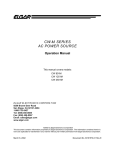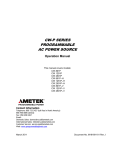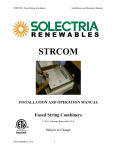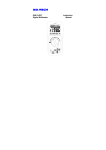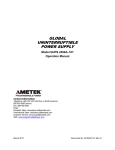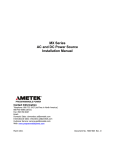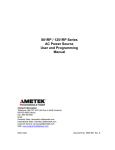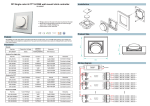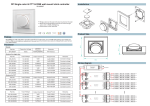Download Elgar CW 2501P Specifications
Transcript
CW-M SERIES AC POWER SOURCE Operation Manual This manual covers models: CW 801M CW 1251M CW 2501M Contact Information Telephone: 800 733 5427 (toll free in North America) 858 450 0085 (direct) Fax: 858 458 0267 Email: Domestic Sales: [email protected] International Sales: [email protected] Customer Service: [email protected] Web: www.programmablepower.com March 2011 Document No. M161570-01 Rev G About AMETEK AMETEK Programmable Power, Inc., a Division of AMETEK, Inc., is a global leader in the design and manufacture of precision, programmable power supplies for R&D, test and measurement, process control, power bus simulation and power conditioning applications across diverse industrial segments. From bench top supplies to rack-mounted industrial power subsystems, AMETEK Programmable Power is the proud manufacturer of Elgar, Sorensen, California Instruments and Power Ten brand power supplies. AMETEK, Inc. is a leading global manufacturer of electronic instruments and electromechanical devices with annualized sales of $2.5 billion. The Company has over 11,000 colleagues working at more than 80 manufacturing facilities and more than 80 sales and service centers in the United States and around the world. Trademarks AMETEK is a registered trademark of AMETEK, Inc. Other trademarks, registered trademarks, and product names are the property of their respective owners and are used herein for identification purposes only. Notice of Copyright CW-M Series AC Power Source, Operation Manual © 2010 AMETEK Programmable Power, Inc. All rights reserved. Exclusion for Documentation UNLESS SPECIFICALLY AGREED TO IN WRITING, AMETEK PROGRAMMABLE POWER, INC. (“AMETEK”): (a) MAKES NO WARRANTY AS TO THE ACCURACY, SUFFICIENCY OR SUITABILITY OF ANY TECHNICAL OR OTHER INFORMATION PROVIDED IN ITS MANUALS OR OTHER DOCUMENTATION. (b) ASSUMES NO RESPONSIBILITY OR LIABILITY FOR LOSSES, DAMAGES, COSTS OR EXPENSES, WHETHER SPECIAL, DIRECT, INDIRECT, CONSEQUENTIAL OR INCIDENTAL, WHICH MIGHT ARISE OUT OF THE USE OF SUCH INFORMATION. THE USE OF ANY SUCH INFORMATION WILL BE ENTIRELY AT THE USER’S RISK, AND (c) REMINDS YOU THAT IF THIS MANUAL IS IN ANY LANGUAGE OTHER THAN ENGLISH, ALTHOUGH STEPS HAVE BEEN TAKEN TO MAINTAIN THE ACCURACY OF THE TRANSLATION, THE ACCURACY CANNOT BE GUARANTEED. APPROVED AMETEK CONTENT IS CONTAINED WITH THE ENGLISH LANGUAGE VERSION, WHICH IS POSTED AT WWW.PROGRAMMABLEPOWER.COM. Date and Revision March 2011 Revision G Part Number M161570-01 Contact Information Telephone: Fax: Email: Web: 800 733 5427 (toll free in North America) 858 450 0085 (direct) 858 458 0267 [email protected] [email protected] www.programmablepower.com i This page intentionally left blank. ii Important Safety Instructions Before applying power to the system, verify that your product is configured properly for your particular application. Hazardous voltages may be present when covers are removed. Qualified personnel must use extreme caution when servicing this equipment. Circuit boards, test points, and output voltages also may be floating above WARNING (below) chassis ground. The equipment used contains ESD sensitive ports. When installing equipment, follow ESD Safety Procedures. Electrostatic discharges might cause damage to the equipment. WARNING Only qualified personnel who deal with attendant hazards in power supplies, are allowed to perform installation and servicing. Ensure that the AC power line ground is connected properly to the Power Rack input connector or chassis. Similarly, other power ground lines including those to application and maintenance equipment must be grounded properly for both personnel and equipment safety. Always ensure that facility AC input power is de-energized prior to connecting or disconnecting any cable. In normal operation, the operator does not have access to hazardous voltages within the chassis. However, depending on the user’s application configuration, HIGH VOLTAGES HAZARDOUS TO HUMAN SAFETY may be normally generated on the output terminals. The customer/user must ensure that the output power lines are labeled properly as to the safety hazards and that any inadvertent contact with hazardous voltages is eliminated. Guard against risks of electrical shock during open cover checks by not touching any portion of the electrical circuits. Even when power is off, capacitors may retain an electrical charge. Use safety glasses during open cover checks to avoid personal injury by any sudden component failure. Neither AMETEK Programmable Power Inc., San Diego, California, USA, nor any of the subsidiary sales organizations can accept any responsibility for personnel, material or inconsequential injury, loss or damage that results from improper use of the equipment and accessories. SAFETY SYMBOLS iii Product Family: CW 801M, CW 1251M, CW 2501M Warranty Period: One Year WARRANTY TERMS AMETEK Programmable Power, Inc. (“AMETEK”), provides this written warranty covering the Product stated above, and if the Buyer discovers and notifies AMETEK in writing of any defect in material or workmanship within the applicable warranty period stated above, then AMETEK may, at its option: repair or replace the Product; or issue a credit note for the defective Product; or provide the Buyer with replacement parts for the Product. The Buyer will, at its expense, return the defective Product or parts thereof to AMETEK in accordance with the return procedure specified below. AMETEK will, at its expense, deliver the repaired or replaced Product or parts to the Buyer. Any warranty of AMETEK will not apply if the Buyer is in default under the Purchase Order Agreement or where the Product or any part thereof: is damaged by misuse, accident, negligence or failure to maintain the same as specified or required by AMETEK; is damaged by modifications, alterations or attachments thereto which are not authorized by AMETEK; is installed or operated contrary to the instructions of AMETEK; is opened, modified or disassembled in any way without AMETEK’s consent; or is used in combination with items, articles or materials not authorized by AMETEK. The Buyer may not assert any claim that the Products are not in conformity with any warranty until the Buyer has made all payments to AMETEK provided for in the Purchase Order Agreement. PRODUCT RETURN PROCEDURE 1. Request a Return Material Authorization (RMA) number from the repair facility (must be done in the country in which it was purchased): In the USA, contact the AMETEK Repair Department prior to the return of the product to AMETEK for repair: Telephone: 800-733-5427, ext. 2295 or ext. 2463 (toll free North America) 858-450-0085, ext. 2295 or ext. 2463 (direct) Outside the United States, contact the nearest Authorized Service Center (ASC). A full listing can be found either through your local distributor or our website, www.programmablepower.com, by clicking Support and going to the Service Centers tab. 2. When requesting an RMA, have the following information ready: Model number Serial number Description of the problem NOTE: Unauthorized returns will not be accepted and will be returned at the shipper’s expense. NOTE: A returned product found upon inspection by AMETEK, to be in specification is subject to an evaluation fee and applicable freight charges. iv CONTENTS 1 INTRODUCTION ............................................................ 1-1 2 SPECIFICATIONS .......................................................... 2-1 2.1 2.2 2.3 2.4 2.5 2.6 2.7 2.8 3 INSTALLATION ............................................................. 3-1 3.1 3.2 3.3 3.4 3.5 3.6 3.7 3.8 3.9 4 Output ..................................................................................................... 2-1 Current .................................................................................................... 2-2 Measurement .......................................................................................... 2-2 Front Panel.............................................................................................. 2-3 Rear Panel Connections ......................................................................... 2-4 Input ........................................................................................................ 2-4 General ................................................................................................... 2-5 Options and Accessories ........................................................................ 2-5 Unpacking ............................................................................................... 3-1 Wire Gauge Selection ............................................................................. 3-2 Mounting Instructions .............................................................................. 3-5 Cooling .................................................................................................. 3-10 Power In Connections ........................................................................... 3-10 Power Out Connections ........................................................................ 3-12 Sense Connections ............................................................................... 3-14 Parallel Connected Units ....................................................................... 3-16 Multiphase Connected Units ................................................................. 3-16 SET-UP .......................................................................... 4-1 4.1 4.2 4.3 M161570-01 CONFIG Dipswitch .................................................................................. 4-1 Setting the CONFIG Dipswitch ................................................................ 4-2 Parallel and Multiphase Configurations ................................................... 4-3 v Elgar CW-M Series 4.4 5 OPERATION ................................................................... 5-1 5.1 5.2 6 Setting the Phase Angle ......................................................................... 4-8 Parallel and Multiphase Operation .......................................................... 5-4 Remote Control Signals .......................................................................... 5-5 MAINTENANCE.............................................................. 6-1 6.1 6.2 Periodic Service ...................................................................................... 6-1 Fuse Replacement .................................................................................. 6-1 List of Figures Figure 1-1. Figure 3-1. Figure 3-2. Figure 3-3. Figure 3-4. Figure 3-5. Figure 3-6. Figure 3-7. Figure 3-8. Figure 3-9. Figure 4-1. Figure 4-2. Figure 4-3. Figure 4-4. Figure 4-5. Figure 4-6. Figure 4-7. Figure 4-8. Figure 4-9. Figure 5-1. Figure 5-2. ContinuousWave (Model CW1251M) Front Panel ......................................... 1-2 Slide Mounting ............................................................................................... 3-5 Mounting Dimensions, Front and Rear Views (CW 801M, CW 1251M) ......... 3-6 Mounting Dimensions, Front and Rear Views (CW 2501M) ........................... 3-7 Mounting Dimensions, Top and Side Views (CW 801M, CW 1251M) ............ 3-8 Mounting Dimensions, Top and Side Views (CW 2501M) ............................. 3-9 Input Power Connections ............................................................................. 3-10 Output Power Connections .......................................................................... 3-13 Output Voltage Sensing Configuration ......................................................... 3-14 Sense Connections ...................................................................................... 3-15 CW Rear Panel .............................................................................................. 4-1 Config Dipswitch, Factory Default Settings .................................................... 4-1 Dipswitch Default Setting, Example 1 ............................................................ 4-2 Dipswitch Default Setting, Example 2 ............................................................ 4-2 Dipswitch Settings for 3-Phase, 2-Paralleled Each, Configuration ................. 4-3 Dipswitch Settings for 6-Parallel Configuration .............................................. 4-4 Dipswitch Settings for 6-Phase Configuration ................................................ 4-5 Dipswitch Settings for 2-Phase Configuration ................................................ 4-6 Dipswitch Settings for 3-Phase Configuration ................................................ 4-7 CW Front Panel Controls ............................................................................... 5-1 External Control Connector ............................................................................ 5-5 List of Tables Table 3–1. Table 3–2. Table 4–1. Table 4–2. Table 6–1. iv Recommended Wire Gauge Selection Guide ............................................ 3-3 Recommended Cables ............................................................................ 3-11 CONFIG Dipswitch Functions.................................................................... 4-2 Phase Angles ............................................................................................ 4-8 Replacement Fuses .................................................................................. 6-1 M161570-01 SECTION 1 INTRODUCTION Elgar's ContinuousWave™ (CW) Series power sources deliver up to 1250 VA in a 2U high (3.5 inches) rackmount chassis, and 2500 VA in a 5.25 inch chassis. This low profile design is also suitable for benchtop use. The CW Series models have three power ratings: 800 VA, 1250 VA, and 2500 VA. The switchmode, Power Factor Corrected (PFC) design efficiently delivers clean AC power. Voltage, current, and frequency settings are quickly adjusted from the front panel knobs (10–turn potentiometers). Also, the sources can be programmed remotely from the rear panel analog port. The output is protected against overvoltage, overcurrent, and overtemperature conditions. They can be easily paralleled in the field with an additional parallel cable. A two-speed fan results in quieter operation at lower power levels. Key features of the CW Series AC power sources include:High performance/value design Output available at front or rear panel Full rated current for two output voltage ranges: 0 to 135 VAC and 0 to 270 VAC Low profile 2U (3.5") rack height for CW 801M and CW 1251M, and 5.25" rack height for CW 2501M Single phase AC output: 45 to 500 Hz Multi phase and paralleling Measures output voltage, current, and frequency Side air intake, exhaust to rear Two large 4-digit, 7-segment LED displays M161570-01 1-1 Elgar CW-M Series Transformer coupled output, 500 VRMS isolation voltage between either output terminal to chassis Power-up to previous front panel setting or 0 Volts (switch selectable) Universal Input: 90–264 VAC (CW 801M), 103–264 VAC (CW 1251M), 180–264 VAC (CW 2501M) Optional front panel locking knobs 1–year calibration interval CE Mark Figure 1-1. ContinuousWave (Model CW1251M) Front Panel 1-2 M161570-01 SECTION 2 SPECIFICATIONS Note: Product specifications are subject to change without notice. 2.1 OUTPUT Power CW 801M: 800 VA CW 1251M: 1250 VA CW 2501M: 2500 VA Power Factor of Load: 0 lag to 0 lead Phase: All models single phase output Voltage Ranges: 0 to 135 VAC RMS or 0 to 270 VAC RMS manual switch (consult factory for custom output voltages) Accuracy: 1% of range for voltages >5V Resolution: 0.1V Total Harmonic Distortion: 0.25% typical <100 Hz add 0.5%/100 Hz above 100 Hz AC Noise Level: <50m VRMS typical for CW 801M and CW 1251M, 100m VRMS typical for CW 2501M Amplitude Stability: ±0.1% of full scale over 8 hours at constant line, load and temperature after 15 minute warm-up M161570-01 2-1 Elgar CW-M Series Load Regulation: ±0.1% of full scale voltage for a full resistive load to no load Line Regulation: ±0.1% of full scale for a ±10% line change from nominal line voltage Remote Voltage Sense: 5 VRMS total lead voltage drop 2.2 CURRENT CW 801M: 6.00 ARMS in 135 VAC range or 3.00 ARMS in 270 VAC range CW 1251M: 9.40 ARMS in 135 VAC range or 4.70 ARMS in 270 VAC range CW 2501M: 18.60 ARMS in 135 VAC range or 9.30 ARMS in 270 VAC range Frequency Range: 45 to 500 Hz Accuracy: ±0.5% typical Resolution: 0.1 Hz 2.3 MEASUREMENT Voltage Range: 0 to 135/270 VRMS Accuracy: ±1% of range for voltages >5V, measured at point of sense Resolution of Display: 0.1V Current Range: 0 to 6.0 ARMS (CW 801M) 0 to 9.4 ARMS (CW 1251M) 0 to 18.6 ARMS (CW 2501M) Accuracy: ±2% of range for linear loads with current >0.2A for CW 801M and CW 1251M, >0.4A for CW 2501M Resolution of Display: 0.1A Frequency Range: 45 to 500 Hz Accuracy: ±0.5% of reading Resolution of display: 0.1 Hz 2-2 M161570-01 Elgar CW-M Series 2.4 FRONT PANEL Controls Power On/Off switch Output On/Off/Reset switch: Operates output isolation relays. Off also resets faults. Voltage Range switch: Selects 135 Vmax or 270 Vmax range (Output switch must be off to change range) Meter Select switch: Current/frequency select Output Voltage: Adjusted using 10–turn potentiometer Output Current: Adjusted using 10–turn potentiometer Output Frequency: Adjusted using 10–turn potentiometer Overvoltage Protection: Settable 5 to 300 VRMS using a 15–turn screwdriver adjust potentiometer Displays Voltage: 4–digit, 7–segment large, green LED display Current or Frequency: 4–digit, 7–segment large, green LED display Protection and Isolation Overvoltage: Set screw adjustable Overcurrent: 10–turn potentiometer Accuracy: ±2% of range for linear loads with current >0.2 A for CW801M and CW1251M, >0.4A for CW2501M. Overtemperature: Internal monitor Isolation Rating: 500V between either output terminal and chassis Indicators Output On: Green LED Voltage Mode: Green LED Current Mode: Green LED Slave Mode: Green LED Fault Mode: Red LED Output Connector Universal single socket connector for front panel power out on CW 801M and CW 1251M Line and neutral terminals can be switched through rear connector interconnect M161570-01 2-3 Elgar CW-M Series 2.5 REAR PANEL CONNECTIONS Input Connector: Covered barrier terminal strip with strain relief Output Connector: Covered barrier terminal strip with strain relief Remote output voltage sense: 5 VRMS max total lead voltage drop Remote Analog Control: Output voltage control 0 to 5 VDC Output frequency control 0 to 5 VDC (max slew rate 5V/second) Dip Switches (see Section SECTION 4 on page 4-1): Master or Slave field configuration Output disable/enable at power-up Overcurrent shutdown enable/disable 2.6 INPUT Voltage and Frequency CW 801M: 90 to 264 VAC, 47 to 63 Hz, single-phase CW 1251M: 103 to 264 VAC, 47 to 63 Hz, single-phase CW 2501M: 180 to 264 VAC, 47 to 63 Hz, single-phase Neutral should be connected to ground at building entrance Max neutral to chassis voltage: 132V RMS Current CW 801M: 13 ARMS max CW 1251M: 18.5 ARMS max CW 2501M: 19.5 ARMS max Power Factor >0.95 at full load nominal line Efficiency >70% at full load 2-4 M161570-01 Elgar CW-M Series 2.7 GENERAL Dimensions CW 801M: 3.5" H (89 mm) x 19" W (483 mm) x 20.6" D (524 mm) CW 1251M: 3.5" H (89 mm) x 19" W (483 mm) x 20.6" D (524 mm) CW 2501M: 5.25" H (133 mm) x 19" W (483 mm) x 20.6" D (524 mm) Weight CW 801M: 48 lbs. (22 kg) CW 1251M: 53 lbs. (24 kg) CW 2501M: 86 lbs. (39 kg) Shipping Weight CW 801M: 56 lbs. (25 kg) CW 1251M: 61 lbs. (28 kg) CW 2501M: 94 lbs. (43 kg) Regulatory Compliance CE mark LVD: EN61010-1:1993 + Amendment 2 EMC: EN55011:1991 Group 1, Class A, EN50082-1:1992 Environmental Cooling: Dual fan speed with side air intake, exhaust to rear Operating Temperature: 0 to 40°C Storage Temperature: -40 to +70°C Humidity: 0 to 85% at 25°C derate to 50% above 40°C (non-condensing) Altitude: Operating full power available up to 6,000 feet, non-operating to 40,000 feet Installation Category III, Pollution Degree 2 FOR INDOOR USE ONLY 2.8 OPTIONS AND ACCESSORIES L: Locking knobs (front panel potentiometers) Rack Slide Kit (Elgar part number K161570-01) Parallel Cable (Elgar part number 890-497-40) M161570-01 2-5 Elgar CW-M Series This page intentionally left blank. 2-6 M161570-01 SECTION 3 INSTALLATION The Elgar CW series power supply has been fully calibrated and tested prior to shipment. The instrument is ready for immediate use upon receipt. CAUTION! The CW unit weighs from 48 to 86 lbs. (22 to 40 kg), depending on the model. A two–person lift is recommended. WARNING! Hazardous voltages are present when operating this equipment. Please read the Safety Notice at the beginning of this manual prior to installation, operation, or maintenance. 3.1 UNPACKING Perform a visual inspection of the shipping container prior to accepting the package from the carrier. If extensive damage to the shipping container is evident, a description of the damage should be noted on the carrier's receipt and signed by the driver of the carrier agent. Perform a visual inspection of the instrument when it is removed from the shipping container. Check for shipping damage such as dents, scratches, distortion, and damaged connectors. If damage is not apparent until the instrument is unpacked, a claim for concealed damage should be placed with the carrier. In addition, the shipping container(s) and filler material should be saved for inspection. Forward a report of damage to the Elgar Service Department. Elgar will provide instructions for repair or replacement of the instrument. M161570-01 3-1 Elgar CW-M Series If the instrument needs to be returned to Elgar, suitable shipping containers and packing materials must be used. If proper packing material is not available, contact Elgar to provide containers and shipping instructions. Before shipping a product to Elgar, you must obtain a Return Material Authorization (RMA) number from Elgar‘s Repair Department. See the warranty page at the front of this manual for details. 3.2 WIRE GAUGE SELECTION The following guidelines assist in determining the optimum cable specification for your power applications. These guidelines are equally applicable to both DC and low frequency AC (up to 450 Hz) power cabling. The same engineering rules apply whether going into or out of an electrical device. Thus, this guide applies equally to the input cable and output cable for this Elgar instrument and application loads. Power cables must be able to safely carry maximum load current without overheating or causing insulation destruction. It is important to everyday performance to minimize IR (voltage drop) loss within the cable. These losses have a direct effect on the quality of power delivered to and from instruments and corresponding loads. When specifying wire gauge, the operating temperature needs to be considered. Wire gauge current capability and insulation performance drops with the increased temperature developed within a cable bundle and with increased environmental temperature. Thus, short cables with generously derated gauge and insulation properties are recommended for power source applications. Avoid using published commercial utility wiring codes, which are designed for the internal wiring of homes and buildings. Although these codes accommodate the safety factors of wiring loss, heat, breakdown insulation, aging, etc., they consider that up to 5% voltage drop is acceptable. Such a loss directly detracts from the quality performance specifications of this Elgar instrument. Frequently, these codes do not consider bundles of wire within a cable arrangement. In high performance applications, as in motor start-up and associated inrush/ transient currents, additional consideration is required. The cable wire gauge must consider peak voltages and currents that may be up to ten times the average values. An underrated wire gauge adds losses that alter the inrush characteristics of the application and thus the expected performance. 3-2 M161570-01 Elgar CW-M Series Table 3–1 identifies popular ratings for DC and AC power source cable wire gauges. Table 3–1. Recommended Wire Gauge Selection Guide Column 1 Size (AWG) Column 2 Amperes (Max) Column 3 Ohms/100 ft (1 way) Column 4 IR Drop/100 ft (Col 2 x Col 3) 14 12 10 8 6 4 2 1/0 3/0 15 20 30 40 55 70 95 125 165 0.257 0.162 0.102 0.064 0.043 0.025 0.015 0.010 0.006 3.85 3.24 3.06 2.56 2.36 1.75 1.42 1.25 1.04 The following notes apply to Table 3–1 and to the power cable definition: 1. 1. The above figures are based upon insulated copper conductors at 25C (77F), two current carrying conductors in the cable plus a safety (chassis) ground. Columns 3 and 4 refer to ―one way‖ ohms and IR drop of current carrying conductors (e.g., a 50-foot cable contains 100 feet of current carrying conductor). 2. Determine which wire gauge for the application by knowing the expected peak load current (Ipeak), the maximum tolerated voltage loss (Vloss) within the cable, and the one way cable length. The formula below determines which ohms/100 feet entry is required from Column 3. Read the corresponding wire gauge from Column 1. (Column 3 value) = Vloss/[Ipeak x 0.02 x (cable length)] Where: Column 3 value = Entry of the table above. Cable length = One way cable length in feet. Vloss = Maximum loss, in volts, permitted within cable. Special case: Should the Vloss requirement be very loose, Ipeak may exceed the maximum amperes (Column 2). In this case, the correct wire gauge is selected directly from the first two columns of the table. Example: A 20 ampere (Ipeak) circuit which may have a maximum 0.5 volt drop (Vloss) along its 15-foot cable (one way cable length) requires (by formula) a Column 3 resistance value of 0.083. This corresponds to wire gauge size 8 AWG. If the cable length were 10 feet, the Column 3 value would be 0.125 and the M161570-01 3-3 Elgar CW-M Series corresponding wire gauge would be 10 AWG. 3. Aluminum wire is not recommended due to soft metal migration at the terminals which may cause long term (on the order of years) poor connections and oxidation. If used, increase the wire gauge by two sizes (e.g., specify 10 gauge aluminum instead of 14 gauge aluminum). 4. Derate the above wire gauge (use a heavier gauge) for higher environmental temperatures since conductor resistance increases with temperature. 5. 6. Temperature Degrees Current Capability C 40 80% F 104 Derate the above wire gauge (use a heavier gauge) for an increased number of current carrying conductors. This offsets the thermal rise of bundled conductors. Number of Conductors Current Capability 3 to 6 Above 6 80% 70% The preferred insulation material is application dependent. Elgar's recommendation is any flame retardant, heat resistant, moisture resistant thermoplastic insulation rated to a nominal 75ºC (167ºF). Voltage breakdown must exceed the combined effects of: The rated output voltage; Transient voltages induced onto the conductors from any source; The differential voltage to other nearby conductors; and, Safety margins to accommodate degradations due to age, mechanical abrasion and insulation migration caused by bending and temperature. 3-4 7. As frequency increases, the magnetic field of the current carrying conductors becomes more significant in terms of adverse coupling to adjacent electrical circuits. Use twisted pairs to help cancel these effects. Shielded twisted pairs are even better. Avoid close coupling with nearby cables by using separate cable runs for high power and low power cables. 8. The above general values and recommendations should be reviewed, modified, and amended as necessary for each application. Cables should be marked with appropriate safety WARNING decals as hazardous voltages may be present. M161570-01 Elgar CW-M Series 3.3 MOUNTING INSTRUCTIONS Refer to Figure 3-1 through Figure 3-4 for mounting dimensions and other installation information for the CW Series power supplies. The units are equipped with mounting feet for bench top use. They are mounted to the chassis with pem-nuts and may be removed easily for rack mount application. The units are 3.5" and 5.25" (89 mm and 133 mm) high, and are designed to be installed in a standard 19" (483 mm) RETMA rack. Pem-nuts have been built into the chassis for mounting optional slides. The CW mounting kit, Elgar part number K161570-01, contains the appropriate slides and mounting brackets. If you elect not to use slides, mount the unit with standard support angles to sustain the weight of the unit in the rack. Note that the front panel mounting ears are not intended to support its weight in rack mounting. For installations that include slides, use a #10 lock washer with each of the two mounting screws indicated in Figure 3-1. The washers are required on the right side only. Figure 3-1. Slide Mounting M161570-01 3-5 Elgar CW-M Series Figure 3-2. Mounting Dimensions, Front and Rear Views (CW 801M, CW 1251M) 3-6 M161570-01 Elgar CW-M Series Figure 3-3. Mounting Dimensions, Front and Rear Views (CW 2501M) M161570-01 3-7 Elgar CW-M Series Figure 3-4. Mounting Dimensions, Top and Side Views (CW 801M, CW 1251M) 3-8 M161570-01 Elgar CW-M Series Figure 3-5. Mounting Dimensions, Top and Side Views (CW 2501M) M161570-01 3-9 Elgar CW-M Series 3.4 COOLING The CW unit employs internal fans to circulate cooling air. The air is drawn into the chassis along its sides, and is exhausted through the rear panel. For maximum product life and reliability, do not allow the airflow to be impeded. CAUTION! Avoid blocking the instrument air intakes or exhaust. 3.5 POWER IN CONNECTIONS Connect input power to the INPUT terminal block on the rear panel as specified below. Refer to Figure 3-6. Figure 3-6. Input Power Connections WARNING! For input voltages >120V, do not reverse LINE and NEUT. Reversed connections will result in pulsing noises from the supply. 3-10 M161570-01 Elgar CW-M Series 3.5.1 SINGLE–PHASE SUPPLY CONNECTIONS 1. Remove the protective cover from the terminal block. 2. Route the cables through the strain relief device. Refer to Table 3–2 for cable recommendations. 3. Connect SAFETY Ground to the Ground stud located next to the INPUT terminal block. For additional safety, include a loop between the Ground stud and the strain relief device, as shown in Figure 3-6. 4. Connect shields, if any, to the GND connector of the INPUT terminal block. 5. Connect NEUTRAL, if available, to the NEUT connector. 6. Connect LINE to the LINE connector. 7. Reinstall the protective cover on the terminal block. Tighten the strain relief device. 3.5.2 SPLIT–PHASE SUPPLY CONNECTIONS 120–0–120V 1. Remove the protective cover from the terminal block. 2. Route the cables through the strain relief device. Refer to Table 3–2 for cable recommendations. 3. Connect NEUT to 120V. 4. Connect LINE to the other 120V. Wiring across the full voltage will allow lower line currents to be used. 5. Reinstall the protective cover on the terminal block. Tighten the strain relief device. 3.5.3 THREE–PHASE SUPPLY CONNECTIONS 1. Remove the protective cover from the terminal block. 2. Route the cables through the strain relief device. Refer to Table 3–2 for cable recommendations. 3. Connect one phase to LINE and NEUTRAL to NEUT. If NEUTRAL is not available, connect LINE and NEUT across any of the phases. 4. Reinstall the protective cover on the terminal block. Tighten the strain relief device. Table 3–2. Recommended Cables CW Model North American International CW 801M 18A/300V, 3x14 AWG O.D.= 9.6 mm 25A/300V, 3x12 AWG O.D.= 11.3 mm 16A/300V, 3x1.5 mm2 O.D.= 8.0–9.8 mm VDE 25A/300V, 3x25 mm2 O.D.= 9.6–12.0 mm VDE CW 1251M and CW 2501M M161570-01 3-11 Elgar CW-M Series WARNING! To protect the operator, the wire connected to the GND terminal must be connected to earth ground. This unit should not be operated without an adequate ground connection. CAUTION! Use wire rated for currents drawn as specified on equipment label. WARNING! A device to disconnect the CW system from the energy supply source is required. This switch or circuit breaker must be close to the CW system, within easy reach of the operator, and clearly labeled as the disconnection device for the CW system. 3.6 POWER OUT CONNECTIONS 1. Remove the protective cover from the terminal block. 2. A factory jumper has been added to connect NEUTRAL to GROUND. If the front connector requires LINE and NEUTRAL to be reversed, move this jumper to connect LINE to GROUND. See Figure 3-7 below. Most loads require NEUTRAL to be grounded. The factory jumper may be removed if the load has a GROUND or if LINE or NEUTRAL voltages are held to less than 500 VRMS with respect to chassis. 3. Reinstall the protective cover on the terminal block. WARNING! Verify that the load is set up to be LINE GROUNDED or NEUTRAL GROUNDED. (Equipment with polarized plugs requires NEUTRAL to be grounded.) 3-12 M161570-01 Elgar CW-M Series Figure 3-7. Output Power Connections M161570-01 3-13 Elgar CW-M Series 3.7 SENSE CONNECTIONS The CW Series unit can be used with or without remote sense leads connected to the load. Where the sense leads (line and neutral sense) are connected determines the point at which the CW output voltage will be precisely regulated. As shipped, the units are configured for local sense operation. This is achieved by connecting shorting jumpers between the sense and AC output terminals of the rear panel output terminal block, as shown in Figure 3-8. When using remote sensing, the shorting jumpers must be removed, and the remote sense leads connected from the CW sense terminals to the load. The point of voltage regulation will now be at the load, and any voltage drop across the interconnecting output cable will be compensated. In the event that the external remote sense circuit opens, the CW maintains control of the output voltage by utilizing a redundant sense circuit. This redundant circuit is comprised of 10kΩ resistors internally connected from the AC output terminals to the voltage control circuitry. However, since the unit is calibrated with the sense leads connected, this mode of operation will incur reduced accuracy in the AC output voltage because of the presence of the 10kΩ resistors. Figure 3-8. Output Voltage Sensing Configuration 3-14 M161570-01 Elgar CW-M Series To utilize remote sensing at the user's load, follow these steps: 1. Remove the protective cover from the terminal block. 2. Route the cables through the strain relief device located above the terminal block. Twisted shielded leads for power and sense leads are recommended for the lowest noise operation. If used, shields should be connected to a CW output terminal block GND ground connector, as shown in Figure 3-9. 3. Disconnect local–sense shorting jumpers. See Figure 3-9. 4. Connect the sense leads as shown in Figure 3-9. 5. Reinstall the protective cover on the terminal block. Figure 3-9. Sense Connections M161570-01 3-15 Elgar CW-M Series 3.8 PARALLEL CONNECTED UNITS To achieve higher output power than what is available from one unit, you can connect up to six units in parallel. This is referred to as ‗master/slave‘ operation. For a master/slave configuration, designate one unit as the master and the others as slaves. This is done by both switch settings (see Section SECTION 4) and wiring connections. Connect the master as described in the preceding steps. Additionally, using the same size and type of wire, make these connections between the master and slaves: Connect from Master Unit: INPUT LINE INPUT GND INPUT NEUT OUTPUT LINE OUTPUT NEUT To Slave Units: INPUT LINE INPUT GND INPUT NEUT OUTPUT LINE OUTPUT NEUT Connect the master unit‘s sense leads either locally or to the load. Do not make any connection to the slave unit‘s SENSE terminals. In addition to the connections just defined, connect a cable (Elgar part number 890-49740) from the master‘s rear panel connector labeled SLAVE OUT to the slave rear panel connectors labeled SLAVE IN. 3.9 MULTIPHASE CONNECTED UNITS Two phase, three phase and six phases can be configured by setting the rear panel switches and attaching cables to connect the units (Elgar part number 890-497-40). See Section SECTION 4 for parallel and multiphase configurations and switch settings. 3-16 M161570-01 SECTION 4 SET-UP Once installation is complete and all cable connections are secure, check the settings on the 12-position CONFIG dipswitch located on the rear panel. Refer to Figure 4-1. Configure the switch prior to applying unit power. Figure 4-1. CW Rear Panel 4.1 CONFIG DIPSWITCH The CONFIG dipswitch comes preset from the factory for stand-alone operation. With these settings, the unit powers up to the current voltage and operates in constant current mode. The dipswitch settings should look like this: 1 2 3 4 5 6 7 8 9 10 11 12 ON OFF Figure 4-2. Config Dipswitch, Factory Default Settings The functions of the CONFIG dipswitch are listed in Table 4–1, followed by descriptions of switch positions to change the default attributes of the unit. M161570-01 4-1 Elgar CW-M Series Table 4–1. CONFIG Dipswitch Functions Switch Position 1,2 ON Required to enable current master and slave operation OFF Stand-alone unit or phase slave ON Current slave OFF Current master ON Phase slave OFF Phase master ON Output disabled at power-up, Fault LED lit 3 4 5 Function Note: If the output switch is in the ON position at power-up, it has to be moved to the OFF/RESET position, then back to the ON position to enable the output OFF Output enabled at power-up 6–7 — Reserved for future expansion 8 ON Constant Current mode OFF Current Shut-off (fault) mode 9–12 4.2 — Phase angle selections (see Table 4–2 on page 4-8) SETTING THE CONFIG DIPSWITCH You may change the CONFIG dipswitch settings to change the default characteristics of the unit as follows: If you would like the power supply to turn its output off, and generate a fault indication if its output current ever reaches the level that you set from the front panel, then set switch 8 to the off position. 1 2 3 4 5 6 7 8 9 10 11 12 ON OFF Figure 4-3. Dipswitch Default Setting, Example 1 To set the power supply to always start up at OV (fault mode) each time that power is applied, set switch 5 to the on position. 1 2 3 4 5 6 7 8 9 10 11 12 ON OFF Figure 4-4. Dipswitch Default Setting, Example 2 4-2 M161570-01 Elgar CW-M Series 4.3 PARALLEL AND MULTIPHASE CONFIGURATIONS To operate parallel and/or multiphase configurations, set the switches, cables, and wiring as shown in the examples below. 4.3.1 SETUP FOR THREE-PHASE, TWO PARALLELED PER PHASE CONFIGURATION Figure 4-5. Dipswitch Settings for 3-Phase, 2-Paralleled Each, Configuration M161570-01 4-3 Elgar CW-M Series 4.3.2 SETUP FOR SIX IN PARALLEL CONFIGURATION Figure 4-6. Dipswitch Settings for 6-Parallel Configuration 4-4 M161570-01 Elgar CW-M Series 4.3.3 SETUP FOR SIX-PHASE CONFIGURATION Figure 4-7. Dipswitch Settings for 6-Phase Configuration M161570-01 4-5 Elgar CW-M Series 4.3.4 SETUP FOR TWO-PHASE CONFIGURATION Figure 4-8. Dipswitch Settings for 2-Phase Configuration 4-6 M161570-01 Elgar CW-M Series 4.3.5 SETUP FOR THREE-PHASE CONFIGURATION Figure 4-9. Dipswitch Settings for 3-Phase Configuration M161570-01 4-7 Elgar CW-M Series 4.4 SETTING THE PHASE ANGLE For multiphase operation, set switches 9 through 12 for the desired phase angle as specified below, in Table 4–2. Table 4–2. Phase Angles Leading Phase Angle 0 30 45 60 90 120 135 150 180 210 225 240 270 300 315 330 Switch 9 ON ON OFF OFF ON ON OFF OFF ON ON OFF OFF ON ON OFF OFF Switch 10 ON OFF ON OFF ON OFF ON OFF ON OFF ON OFF ON OFF ON OFF Switch 11 ON ON ON ON ON ON ON ON OFF OFF OFF OFF OFF OFF OFF OFF Switch 12 ON ON ON ON OFF OFF OFF OFF ON ON ON ON OFF OFF OFF OFF The CW-M Series front panel display for B Phase and C Phase units will display the leading phase angle in degrees that the DIP switches have been set for. For a typical 3 phase set-up, the CW-M Units and phase angle relationships are: The A Phase at 0°, or reference phase. Switches 9 through 12 should be ON for the A Phase Master CW-M Unit to set 0°. The B Phase is set for a +240° or 240° leading phase angle (same as a 120° or 120° lagging phase angle) relative to A Phase at 0° Reference. This would have Switch 9 OFF, Switch 10 OFF, Switch 11 OFF, and switch 12 ON. The C Phase is set for a +120° or 120° leading phase angle (same as a 240° or 240° lagging phase angle) relative to A Phase at 0° Reference. This would have Switch 9 ON, Switch 10 OFF, Switch 11 ON, and switch 12 OFF. In this fashion, the phase rotation/sequence will be A-B-C-A-B-C etc. 4-8 M161570-01 SECTION 5 OPERATION The controls and indicators for the CW series power source are detailed below in Figure 5-1. Figure 5-1. CW Front Panel Controls POWER SWITCH Press the top portion of the switch to turn power on, press the bottom portion of the switch to turn the power supply off. When power is turned on, the unit goes through a power up cycle that may take several seconds before it is ready for operation. VOLTAGE CLUSTER These five controls and indicators, located to the right of the Power Switch, are used to select and display the power supply‘s output voltage. M161570-01 5-1 Elgar CW-M Series V RANGE HIGH/LOW Switch. This switch allows you to select the 0V-135V range or the 0V-270V range of output voltage. The output current available on the low voltage range is twice that available on the high voltage range. NOTE: This switch should not be toggled while the system output is turned on. Doing so will cause the output to turn off, and a fault condition will be indicated. CAUTION! To protect the load, ensure that the output of the CW unit is turned off before using the V RANGE switch. NUMERIC DISPLAY. This large, four-digit display, located in the voltage cluster, is a digital voltmeter that measures and displays the power supply‘s output voltage. If the power supply is operating, but the output power is turned off, then this meter displays the voltage that the output will assume when it is turned on. VOLTAGE MODE LAMP. This lamp, located directly over the numeric display, indicates that the power supply is operating in the constant output voltage mode. This is the most common operation mode used. If the output current rises above the level set by the current program level, this lamp turns off and the CURRENT MODE lamp turns on. VOLTAGE Knob. This large, multi-turn knob, at the right side of the voltage cluster of controls, allows you to easily select the desired power supply output voltage. SET OVP. This is a screwdriver accessible, multi-turn adjustment located directly under the display. To define a maximum output voltage, first turn the adjusting screw fully clockwise. Set the output voltage to the desired trip point. Then, slowly, turn the adjustment counter-clockwise until a fault is generated, turning the output off. CURRENT/FREQUENCY CLUSTER These six controls and indicators, located in the center of the front panel, are used to select and display the CURRENT and FREQUENCY. MEAS/PROG Switch. This switch selects which current measurement is sent to the meter. If the meter has been set to display current, and this switch is set to MEAS, then the measured output current is displayed. If this switch is set to PROG, then the selected current limit point is displayed. CURR/FREQ Switch. This switch selects the type of quantity to be displayed. Selecting CURR displays the selected current, either meas or prog. Selecting FREQ displays the operating frequency. Numeric Display. The large, four-digit display in the current/frequency cluster shows the measured quantities described above. 5-2 M161570-01 Elgar CW-M Series CURRENT MODE Lamp. This lamp, located directly over the numeric display, indicates when the output current has reached its selected limiting value, i.e., the power supply is operating in the constant current mode. CURRENT Knob. A large, multi-turn knob allows you to set the point of inception of the constant current mode. FREQUENCY Knob. A large, multi-turn knob allows you to set the operating frequency. FAULT LAMP When lit, this lamp indicates that a fault condition has been detected, and that the system output has been turned off automatically. Some conditions that cause this to occur include: output over-voltage, output over-current, high internal temperature, changing the output voltage range while the output is turned on, starting the system with the output turned on and the unit in power up to zero volts mode, or an internal system failure. SLAVE LAMP When lit, this lamp indicates that the unit is operating in the slave mode. OUTPUT ON LAMP When lit, this lamp indicates that the output switch has been set to the on position, and power is on the output terminals. OUTPUT ON/OFF/RESET SWITCH Located on the right side of the front panel, this switch allows you to energize the output terminals of the power supply. If the unit is operating in the fault mode, and if the fault condition has cleared, then cycling this switch will restore normal operation. M161570-01 5-3 Elgar CW-M Series 5.1 PARALLEL AND MULTIPHASE OPERATION Follow the instructions in Section 3.8, Section 3.9, and Section SECTION 4 to set up paralleled or multiphase units. Turn on the slaves prior to the master unit. If the master is tuned on first, it will initialize in a fault condition, and it will need to be reset. If a fault occurs, the fault light on the unit with the fault and the fault light on the master will light. Once the cause of the fault has been corrected, toggle the OUTPUT ON/OFF/RESET switch on the master to reset all of the units. The unit designated as the phase and current master controls the OUTPUT ON/OFF/RESET switch and the V RANGE HIGH/LOW switch. The Voltage LED, Current LED, current setting, and frequency setting user controls have no functionality on current slaves (parallel units). The phase master controls the range HIGH/LOW function for all units. However, to display the correct voltage of the output on phase slaves, set the V RANGE switches to match the phase master. The OUTPUT ON/OFF/RESET switch positions of the slaves do not matter. The master controls all units, and its LED indicates the state of the system. Phase slaves display their phase angle instead of frequency. The phase master displays the system frequency. Each unit in the configuration monitors and displays its own load current. Voltage is displayed only on the master; voltage is blanked out on the current slaves. Voltage of phase slaves can be adjusted independently of the master, from 0V RMS to approximately 20% of full scale above the master (but not exceeding the full-scale range). 5-4 M161570-01 Elgar CW-M Series 5.2 REMOTE CONTROL SIGNALS A nine-pin ‗D‘ connector on the rear panel, marked EXT CONTROL, provides for the application of DC voltage signals to control both the voltage amplitude and frequency of the power supply‘s output signal. A 0V–5V signal has full scale control over either function. The effect of the external analog control signal is additive with the setting of the function‘s front panel control setting. The combined effect is full scale limited. The impedance of the external analog control inputs is 10k ohms, nominal. Connect the voltage control signal to pin 1. Connect the frequency control signal to pin 2. Pin 3 is the common return for all signals. See Figure 5-2. Pin # 1 2 3 4–9 Function Analog voltage programming 0 to 5 VDC full scale Analog frequency programming 0 to 5 VDC full scale Analog ground common return for all signals Reserved for future expansion Figure 5-2. External Control Connector Note: When programming voltage through the EXT CONTROL connector, the analog frequency programming signal, if not used, must be tied to analog ground. When programming frequency through the EXT CONTROL connector, the analog voltage programming signal, if not used, must be tied to analog ground. Failure to do so will not harm the unit, but changing either the programmed voltage or frequency would alter the programmed value of the other. On Pin 3, analog ground common must be held within 5 V DC of chassis. M161570-01 5-5 Elgar CW-M Series This page intentionally left blank. 5-6 M161570-01 SECTION 6 MAINTENANCE 6.1 PERIODIC SERVICE No routine maintenance on the CW Series unit is required, aside from periodic cleaning. Once a unit is removed from service, it may be cleaned with isopropyl alcohol (or an equivalent solvent) on the metal surfaces, and a weak solution of soap and water on the front panel. Low pressure compressed air may be used to remove dust from in and around components on the printed circuit boards. 6.2 FUSE REPLACEMENT Replacement fuses for the CW Series supply are listed below in Table 6–1. Table 6–1. Replacement Fuses Ref. Designator Location Rating Manufacturer Mfr. P/N Elgar P/N F1, F2 Motherboard 25A, 250V, T Bussmann MDA-V-25 858-325-25 F3 Motherboard 1A, 250V, T Bussmann Littelfuse C515-1A 230-001S 858-250-11 858-250-11 F4 (CW 801-M, CW 1251-M) Motherboard 10A, 500V DC Littelfuse KLKD10 858-601-10 F4 (CW 2501-M) Motherboard 15A, 500V DC Littelfuse KLKD15 858-601-15 CAUTION! Fuse replacement should be performed by qualified service personnel only. Breaking the quality seal will invalidate the warranty. M161570-01 6-1 Elgar CW-M Series This page intentionally left blank. 6-2 M161570-01
















































